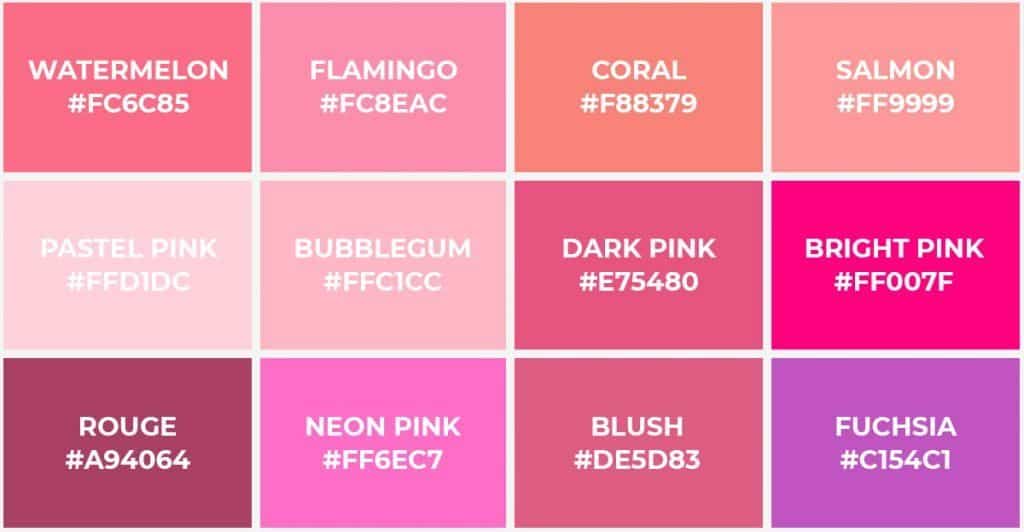Pink is a very popular color that comes in many shades. The specific RGB code of pink depends on the exact shade you are looking for. RGB stands for red, green, blue – the three primary colors that computers and screens use to display color. By mixing different amounts of red, green, and blue light, millions of colors can be created. To define a specific shade of pink in RGB, you need to know the exact ratio of red, green, and blue required to produce that color. This article will examine the RGB codes for some of the most common shades of pink.
How RGB Color Codes Work
RGB color codes are made up of three numbers ranging from 0 to 255 separated by commas. Each number represents the amount of red, green or blue needed to make up the color.
For example:
| RGB Color Code | Amount of Red | Amount of Green | Amount of Blue |
| 255, 0, 0 | 255 | 0 | 0 |
This code means full red, no green, and no blue, which together make up the color red.
By mixing different ratios of red, green and blue, millions of color combinations are possible. Lower numbers mean less of that color is used.
Pink RGB Codes
Here are some common shades of pink and their corresponding RGB codes:
| Pink Shade | RGB Code |
| Baby Pink | 255, 182, 193 |
| Pastel Pink | 255, 209, 220 |
| Bright Pink | 255, 105, 180 |
| Hot Pink | 255, 0, 127 |
| Deep Pink | 255, 20, 147 |
| Pale Pink | 255, 228, 225 |
| Fuschia Pink | 255, 0, 255 |
As you can see, all shades of pink involve a higher amount of red, combined with varying amounts of green and blue.
The more red in the RGB code, the more vibrant and intense the pink color will be. Pastel pink shades have more green and blue mixed in to soften the tone.
Most Common Shades of Pink
Some of the most universally recognized pink shades include:
Hot Pink
Hot pink has an RGB code of 255, 0, 127 and gets its name from being a vivid, intense pink tone. The lack of green gives hot pink a bright, sensational appearance. This shade is bold, youthful and energetic.
Baby Pink
Baby pink has an RGB code of 255, 182, 193. This is a soft, light pink pastel shade associated with babies and femininity. The higher amounts of green and blue create a gentle, calming color.
Fuchsia Pink
Fuchsia pink is a vivid reddish-purple tone closer to magenta on the color wheel. Its RGB code is 255, 0, 255. The equal amounts of red and blue with no green give fuchsia an eye-catching appeal.
Pastel Pink
Pastel pink has an RGB code of 255, 209, 220. This soft, delicate pink is created by mixing in higher amounts of green and blue. Pastel pink has a gentle, calming effect.
Uses of Pink Shades
Different pink shades lend themselves to certain uses and contexts:
Baby Pink
– Associated with infants and baby girls
– Used for baby clothes, nurseries, and baby shower themes
– Represents innocence and femininity
Pastel Pink
– Favored for women’s fashion and accessories
– Used in interiors to create a soft, peaceful mood
– Pairs nicely with other pastel colors like mint green or lavender
Hot Pink
– Makes a bold, vibrant fashion statement
– Grabs attention when used in advertising or web design
– Conveys youthful energy and modern flair
Fuchsia Pink
– Dramatic, artsy tone suitable for graphic design
– Stands out in fashion when mixed with black
– Used in beauty and cosmetic packaging and logos
Psychological Effects of Pink
Pink is strongly associated with feminine qualities as well as love, romance and emotional warmth. Different hues of pink can provoke different psychological reactions:
Light Pink
– Calming, peaceful, innocent
– Associated with gentleness and romance
Bright Pink
– Energetic, fun, flirtatious
– Evokes playfulness and lightheartedness
Deep Pink
– Sensual, intimate, loving
– Related to physical and emotional passion
Pink in Branding and Marketing
Pink is extremely effective in certain types of branding and marketing:
Targeting Women
Pink connects to stereotypical femininity. Brands use it to appeal directly to female consumers.
Beauty Industry
Cosmetics, skincare and beauty brands often utilize pink for packaging and branding.
Bakeries and Sweets
Pink gives a delicate, appetizing impression associated with desserts.
Romance Products
Pink promotes emotional warmth and love. Romantic restaurants, lingerie stores, dating services, etc. leverage pink in their marketing.
Breast Cancer Awareness
The pink ribbon is the universal symbol of breast cancer awareness. Pink promotes healing and hope.
Conclusion
There are many shades of pink each with their own distinctive RGB code. While pink has strong feminine connotations, different hues can convey different qualities from innocence to playfulness to romance. When used strategically, pink is an impactful color choice in branding, marketing, fashion and more. Regardless of application, pink’s cheerful essence makes it a beloved color.


